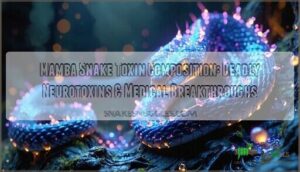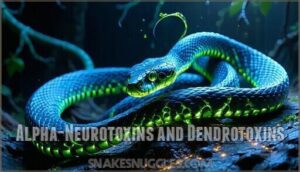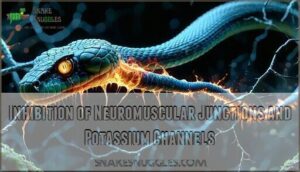This site is supported by our readers. We may earn a commission, at no cost to you, if you purchase through links.

These African serpents pack a venomous punch that’s like a molecular Swiss Army knife.
Their venom contains primarily dendrotoxins (Kunitz-type inhibitors) and three-finger toxins that target your nervous system with surgical precision.
Think of dendrotoxins as cellular bouncers – they block potassium channels in nerve cells, preventing normal electrical signals.
The three-finger toxins bind to acetylcholine receptors, basically jamming your body’s communication network.
Surprisingly, the venom also contains high levels of adenosine, a nucleoside that affects circulation.
But here’s where things get interesting for medical researchers, as the unique composition of mamba snake venom, including its three-finger toxins, presents a complex and intriguing subject for study.
Table Of Contents
- Key Takeaways
- Overview of Black Mamba Venom Composition
- Neurotoxic Components of Black Mamba Venom
- Functional Understanding of Mamba Toxins
- Medical Management of Black Mamba Envenomation
- Research Implications and Application Potentials
- Frequently Asked Questions (FAQs)
- What is the toxin in a mamba snake?
- What kind of poison does a mamba have?
- What is the chemical composition of snake venom?
- What are the ingredients in snake poison?
- What is the composition of the black mamba venom?
- What is the chemical composition of the mamba?
- What is the composition of snake toxin?
- What is the neurotoxin in black mamba venom?
- How do environmental factors affect mamba venom potency?
- Are there variations in venom between different mamba species?
- Conclusion
Key Takeaways
- You’ll encounter a lethal molecular cocktail when dealing with mamba venom – it’s primarily composed of dendrotoxins (Kunitz-type inhibitors) and three-finger toxins that systematically shut down your nervous system by blocking potassium channels and jamming acetylcholine receptors.
- Your survival depends on immediate antivenom administration since mamba venom causes paralysis within minutes – the neurotoxic components work synergistically to prevent nerve signal transmission and muscle contraction, making rapid medical intervention critical.
- You can’t predict exactly what you’re facing because mamba venom composition varies significantly based on the snake’s diet, habitat, age, and geographic location – these environmental factors create unique toxin profiles that affect antivenom effectiveness across different populations.
- You’re witnessing deadly venom transform into life-saving medicine as researchers customize mamba toxins for therapeutic applications – scientists are turning these molecular assassins into precision treatments for neurological diseases like Alzheimer’s by targeting specific brain receptors.
Overview of Black Mamba Venom Composition
When you examine black mamba venom under a microscope, you’ll discover it’s like nature’s deadliest cocktail – a complex mixture of proteins, peptides, and enzymes that makes this snake’s bite so incredibly dangerous.
Black mamba venom: nature’s molecular assassin, engineered over millions of years to kill with terrifying precision.
What’s fascinating is that this venom composition isn’t identical across all black mambas; factors like their diet, habitat, and even age can influence the exact blend of toxins they produce.
Making each encounter uniquely unpredictable.
Proteins, Peptides, and Enzymes
Black mamba venom packs a lethal punch through its intricate blend of venom proteins, snake venom peptides, and venom enzymes.
This biological arsenal demonstrates remarkable peptide diversity and enzymatic activity that’s been fine-tuned through toxin evolution.
Scientists use venom proteomics for toxin characterization, revealing how venom synergism amplifies mamba venom toxins‘ deadly efficiency in this molecular masterpiece.
Variability Across Snake Species
Different mamba species pack completely different venomous punches, even when they’re close cousins. Geographic variation shapes each species’ unique toxin cocktail, while venom evolution creates distinct profiles across populations.
Mamba venoms contain three-finger toxins, which contribute to their neurotoxic effects.
Here’s what drives mamba venom composition differences:
- Venom variability between species affects antivenom effectiveness
- Mamba snake species show distinct toxin profiles despite shared ancestry
- Regional populations develop unique mamba venom toxins based on local pressures
- Mamba venom composition varies substantially across sub-Saharan Africa
- Species-specific differences require targeted medical treatments
Factors Affecting Composition: Diet, Habitat, Age
Venom composition isn’t set in stone – it’s constantly shifting based on what’s happening around these deadly serpents. Dietary influence drives the biggest changes, as mamba venom composition adapts to target specific prey through accelerated toxin gene evolution.
Environmental factors like climate and competition shape venom variability across different populations. Mamba venom contains a variety of pharmacologically active proteins that have potential uses in medicine.
Here’s how ecological factors reshape this lethal cocktail:
- Prey adaptation: Toxin genes duplicate and modify to match hunting targets
- Habitat impact: Geographic location determines toxin diversity and abundance
- Age variation: Maturation process alters toxin proportions from juvenile to adult
- Venom yield: Environmental stress affects protein expression in venom glands
Neurotoxic Components of Black Mamba Venom
When you encounter a black mamba’s venom, you’re facing nature’s most efficient neural saboteur—alpha-neurotoxins that shut down your nerve signals like a master electrician cutting power lines.
These molecular assassins work alongside dendrotoxins to block the potassium channels that keep your muscles firing, creating a deadly one-two punch that’ll leave you paralyzed faster than you can say "antivenom.
Alpha-Neurotoxins and Dendrotoxins
When you’re dealing with mamba venom composition, alpha-neurotoxins and dendrotoxins represent the most dangerous neurotoxic components.
These venom neurotoxins work through distinct receptor binding mechanisms – alphaneurotoxins target nicotinic acetylcholine receptors while dendrotoxins block potassium channels.
Their synergistic effects create rapid paralysis induction, making black mamba bites potentially fatal.
Understanding these neurotoxin mechanisms helps researchers develop better antivenoms and discover therapeutic applications for treating neurological conditions.
Mechanism of Postsynaptic Blockade
When snake venom peptides enter your bloodstream, they’re like molecular keys targeting specific cellular locks.
These threefinger toxins demonstrate incredible toxin affinity for nicotinic receptors, causing signal disruption and eventual paralysis onset through postsynaptic blockade.
- Receptor binding blocks nerve transmission at neuromuscular junctions completely
- Neurotoxic components prevent muscle contraction by occupying acetylcholine receptor sites
- Antivenom effects work by neutralizing these deadly molecular interactions quickly
Inhibition of Neuromuscular Junctions and Potassium Channels
Beyond blocking receptors, mamba dendrotoxins create havoc by jamming potassium channels like a wrench in machinery.
These neurotoxic components prevent nerve signals from properly resetting, while Alpha-Neurotoxin Action shuts down neuromuscular junctions completely.
The result? Paralysis Mechanisms that work through Synergistic Toxicity.
It’s worth noting that some rattlesnakes also possess neurotoxic venom.
| Toxin Type | Target | Effect |
|---|---|---|
| Dendrotoxins | Potassium channels | Channel Blockade |
| Alpha-neurotoxins | Acetylcholine receptors | Signal termination |
| Combined action | Multiple pathways | Complete paralysis |
| Snake venom peptides | Various ion channels | Dendrotoxin Effects |
This Synergistic Toxicity makes treatment challenging.
Functional Understanding of Mamba Toxins
You’ll discover that mamba toxins work like molecular keys, with muscarinic toxins specifically targeting your brain’s acetylcholine receptors—particularly the M1 subtype that’s essential for memory and learning.
Understanding how these toxins bind so precisely to specific receptor sites isn’t just fascinating biology; it’s opening doors to potential treatments for neurological diseases like Alzheimer’s.
Muscarinic Toxins and Acetylcholine Receptors
Think of muscarinic toxins as molecular pickpockets targeting your acetylcholine receptors.
These sneaky components from mamba snake venom hijack signaling pathways, causing conformational changes that disrupt normal nerve function.
What’s fascinating? Scientists are studying their toxin selectivity across receptor subtypes for therapeutic applications.
These neurotoxic components might reveal treatments for neurological diseases—turning deadly into lifesaving.
Specific Binding to M1AChR
When MT7 toxin meets M1AChR, it’s like finding the perfect dance partner.
This MT7 Specificity creates a pseudoirreversible bond through van der Waals interactions, fundamentally altering Receptor Functionality.
Muscarinic toxins from black mamba venom bind so precisely to acetylcholine receptors that researchers can now engineer Therapeutic Customization.
These Signaling Alterations in M1AChR offer promising Alzheimers Implications, transforming deadly mamba snake toxin composition into potential life-saving treatments.
Implications for Neuronal Function and Disease
Your brain becomes a battleground when mamba snake toxin composition disrupts neuronal function through targeted attacks on acetylcholine receptors.
Here’s what happens:
- Neurotoxin Mechanisms flood synapses, causing immediate synaptic dysfunction
- Cognitive Effects emerge as muscarinic toxins hijack normal brain communication
- Disease Modeling reveals connections between venom and Alzheimer’s disease progression
- Therapeutic Targets open potential treatments for neurodegenerative conditions
Understanding these deadly interactions creates unexpected medical opportunities.
Medical Management of Black Mamba Envenomation
When you’re dealing with a black mamba bite, you’re racing against one of nature’s most efficient killing machines—and time isn’t on your side.
You’ll need immediate antivenom administration and proper first-aid techniques to counter the venom’s rapid neurotoxic assault, which can shut down your nervous system within minutes.
Importance of Early Antivenom Administration
Regarding black mamba envenomation, antivenom efficacy depends entirely on speed.
You’ve got a narrow window before symptom severity escalates dramatically. Rapid treatment with antivenom administration can mean the difference between life and death.
Survival rates plummet as black mamba venom spreads through your system. Antivenom therapy works best when snakebite treatment begins immediately—don’t hesitate.
Proper storage can affect antivenom product quality.
Symptoms and Clinical Course
Most black mamba venom victims experience symptom onset within ten minutes of envenomation.
You’ll face a terrifying cascade of neurological symptoms as paralysis progression begins at your extremities and advances toward critical organs.
The venom’s neurotoxic effects create a perfect storm of complications.
- Chest tightness and difficulty breathing signal impending respiratory failure
- Cardiovascular effects including rapid heart rate and blood pressure changes
- Long-term effects requiring extended snakebite treatment and antivenom administration monitoring
First-Aid and Antivenin Therapy
Four critical steps can save your life after a black mamba bite.
Apply pressure immobilization immediately—never use tourniquets due to tissue damage risks.
Remove jewelry before swelling starts.
Neurotoxins cause paralysis within minutes of a bite.
Rush to get antivenom within hours for best survival odds.
Proper firstaid and antivenin therapy mean everything when dealing with deadly snake venom.
Quick symptom recognition and post-treatment care matter too.
Research Implications and Application Potentials
You’ll find that mamba toxins aren’t just nature’s deadliest weapons—they’re becoming tomorrow’s life-saving medicines.
Scientists can now customize these molecular assassins to target specific diseases like Alzheimer’s, turning what once meant certain death into potential therapeutic breakthroughs.
Drug Development and Customization
Scientists are turning mamba snake toxin composition into medical gold through venom therapeutics. You’re witnessing toxin modification that transforms deadly muscarinic toxins into precision medicines.
Researchers customize these molecules for receptor targeting, creating treatments that hit specific acetylcholine receptors with sniper-like accuracy.
This venom customization revolution offers:
- Drug screening platforms that rapidly identify therapeutic candidates
- Alzheimers applications targeting M1 receptors in brain tissue
- Cost-effective alternatives to traditional drug development methods
Bushmaster venom also shows promise, with peptides aiding cancer treatment research. Nature’s deadliest cocktail becomes tomorrow’s life-saving prescription.
From nature’s most lethal weapon to humanity’s next medical breakthrough—venom research is rewriting the rules of drug discovery.
Insights Into Venom Effects
When you explore mamba snake toxin composition, you’re uncovering nature’s blueprint for precision warfare.
Venom effects reveal how toxin mechanisms exploit receptor interactions through venom synergism—multiple components working together like a deadly orchestra.
Neurotoxins don’t just paralyze; they teach us about toxin specificity and evolutionary pressures that shaped these weapons.
Understanding cardiovascular effects opens doors to therapeutic mimicry, where nature’s deadliest secrets become tomorrow’s life-saving medicines.
The effects can be mitigated with specialized venom products.
Advanced Photon Source Contribution
Through advanced X-ray crystallography, the Advanced Photon Source reveals how black mamba venom proteins bind at atomic levels.
This structural insights gained from toxin complex data accelerates drug development impact by transforming deadly compounds into therapeutic tools.
You’re witnessing antivenom advancements that could save thousands of lives.
The facility’s high-resolution imaging discloses therapeutic applications hidden within snake venom, revolutionizing toxin composition understanding for medical breakthroughs.
You can find related merchandise for sale online.
Frequently Asked Questions (FAQs)
What is the toxin in a mamba snake?
One bite delivers death’s cocktail—you’re facing alpha-neurotoxins and dendrotoxins that’ll shut down your nervous system fast. These proteins block nerve signals, causing paralysis and respiratory failure within minutes.
What kind of poison does a mamba have?
Mamba snakes don’t actually have poison—they have venom, which they inject through fangs.
You’ll encounter potent neurotoxins like alpha-neurotoxins and dendrotoxins that attack your nervous system, causing paralysis and potentially death.
What is the chemical composition of snake venom?
Snake venom contains roughly 20-100 different proteins and peptides per species.
You’ll find enzymes, neurotoxins, and hemotoxins working together like a molecular cocktail, with proteins making up 90-95% of the venom’s dry weight composition, including proteins.
What are the ingredients in snake poison?
You’ll find venom contains proteins, peptides, enzymes, carbohydrates, nucleosides, amino acids, and lipids.
These toxic cocktails vary by species, with neurotoxins, blood clotting agents, and tissue-destroying compounds creating life-threatening effects when injected.
What is the composition of the black mamba venom?
Black mamba venom contains 1% Kunitz-type peptides and 31% three-finger toxins. You’ll find alpha-neurotoxins, dendrotoxins, fasciculins, and calciseptine – but surprisingly, no phospholipase A2 enzymes like other snake venoms contain.
What is the chemical composition of the mamba?
You’ll find these venomous serpents pack a deadly cocktail of proteins and peptides.
Their venom contains Kunitz-type peptides (61%), three-finger toxins (31%), dendrotoxins, and alpha-neurotoxins that target your nervous system with frightening efficiency, including alpha-neurotoxins.
What is the composition of snake toxin?
You’ll find snake toxins contain complex mixtures of proteins, peptides, and enzymes.
These components vary by species, with neurotoxins targeting your nervous system and other molecules affecting blood clotting and tissue damage mechanisms, including complex mixtures that can have various effects.
What is the neurotoxin in black mamba venom?
Unlike gentle garden snakes, you’re dealing with nature’s deadliest cocktail.
Black mamba venom contains alpha-neurotoxins and dendrotoxins that’ll shut down your nervous system, blocking nerve signals and causing rapid paralysis within minutes, due to the presence of dendrotoxins.
How do environmental factors affect mamba venom potency?
You’ll find that temperature, humidity, and seasonal changes directly impact your mamba’s venom strength.
Warmer climates boost toxin concentration, while cooler environments reduce potency.
Diet availability and stress levels also influence how deadly the venom becomes.
Are there variations in venom between different mamba species?
Yes, you’ll find significant differences between mamba species’ venoms.
Green mambas contain more phospholipase A2 enzymes, while black mambas have mainly Kunitz-type peptides and three-finger toxins, creating distinct toxicity profiles and symptoms.
Conclusion
Despite what you might think, studying deadly venoms isn’t just academic curiosity—it’s revolutionizing medicine.
Understanding mamba snake toxin composition has already led to breakthrough treatments for neurological disorders and chronic pain.
You’re witnessing how nature’s most lethal compounds become tomorrow’s life-saving drugs. Researchers continue deciphering these molecular secrets, transforming dendrotoxins and three-finger toxins from instruments of death into tools of healing.
The deadliest cocktails often brew the most promising cures.
- https://orbit.dtu.dk/files/126906680/Unveiling_the_nature_of_black_mamba_Dendroaspis_polylepis_venom_through_venomics_and_antivenom_immunoprofiling_postprint.pdf
- https://www.nature.com/articles/s41570-022-00393-7
- https://www.sciencedirect.com/topics/medicine-and-dentistry/dendrotoxin
- https://pmc.ncbi.nlm.nih.gov/articles/PMC9185726/
- https://en.wikipedia.org/wiki/Black_mamba














